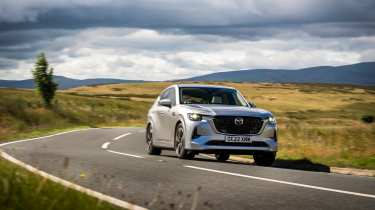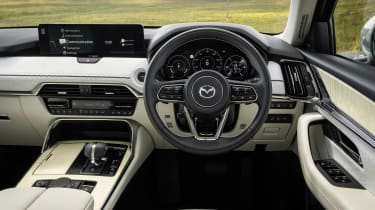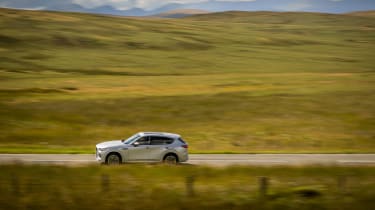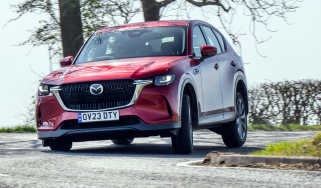Mazda CX-60 2023 review
The CX-60 is a statement of intent against BMW, Mercedes and Audi. We’ll just need to wait and see if they do anything more 'evo' with it
I’d like you to ignore the plug-in hybrid SUV bit of the CX-60 for a second and consider instead that this new and otherwise fairly uninteresting Mazda isn’t just any new model, but representative of a whole new era for the quirky Japanese brand. Granted, we’d prefer it if that was something a little less family and eco-focused, but such is the current new car market one can understand the need to launch it in the form of a desirable midsize SUV.
So what is the new CX-60 and why is it any different? Well apart from being Mazda’s first plug-in hybrid in Europe, it’s actually the first of a whole new generation of models that aren’t just merely being pushed up into the premium space on account of marketing speak, but designed from the get-go to be every bit the BMW, Mercedes-Benz and Audi rival.
> Mazda CX-80 2025 review – Japan’s six-cylinder SUV eyes BMW X5
This much is obvious from the moment you look at the CX-60, as behind the stylish yet familiar Mazda design language sits a brand new architecture that’s rear-wheel-drive-based and designed specifically to fit new in-line six-cylinder combustion powertrains.
The new sixes will be petrol and diesel, both chock-full of new energy-saving technologies including a 48V mild-hybrid system. The petrol will also include Mazda’s clever compression and spark Skyactiv-X ignition system, and is naturally aspirated. Yes, Mazda’s launching a naturally aspirated straight-six petrol engine. In 2023. Brilliant.
Until then, there’s this solitary plug-in hybrid powertrain that combines a naturally aspirated 2.5-litre four-cylinder petrol engine with a single electric motor and 17.8kWh battery package. Mazda estimates a 39-mile all-electric range is possible with a full battery, and we found around 30 miles in a mix of motorway and town driving to be more accurate. Figures generated from the petrol engine are relatively low-strung at 188bhp and 192lb ft of torque, but the electric motor contributes a chunky 172bhp making the CX-60 PHEV the most powerful Mazda ever with combined figures of 322bhp and 369lb ft. This power will send the all-wheel-drive CX-60 to 62mph in 5.8sec, yet as with all plug-ins, these numbers aren’t as critical as how the powertrain feels on the road.
More reviews
Group tests
- Alpine A290 v Alpine A110 – how much DNA do they really share?
- Ariel Atom 4R v Caterham Seven ‘evo25’: power-to-weight heroes go head-to-head
- Caterham Super Seven 600 v Super Seven 2000
- Levante v T1
- Corvette Stingray v Porsche Cayman GTS v Audi R8 RWD
- Great Ferrari hypercars driven: 288 GTO, F40, F50 and Enzo head-to-head
- Hardcore Ferrari V8 specials go head-to-head
- Lamborghini Aventador Ultimae v Lamborghini Countach
- Lotus Emira v Morgan Plus Four – four-cylinder Brits go head-to-head
- Toyota GR86 v BBR Mazda MX-5: supercharged drop-top battles sports coupe
In-depth reviews
- Abarth 600e 2025 review – Italy gives the Alpine A290 something to worry about
- Alpine A110 review – distinctive, lightweight and unforgettable to drive
- Audi R8 (2015 - 2024) review – the ultimate soft-focus supercar
- Bentley Continental R Mulliner: review, history and specs
- BMW 5-series review – is this still Munich’s anchor model?
- BMW 1-series review – Munich’s Audi A3 rival gains focus
Long term tests
- Abarth 695C Turismo Fast Fleet test – 10,000 miles in the Italian hot hatch
- Alfa Romeo Giulia Veloce Fast Fleet test – 7000 miles in the sharp Italian saloon
- Alpina B10: end of term report
- Alpina B10
- Ford Mustang GT
- Ford Mustang GT
- Ford Mustang GT
- Land Rover Defender 110 Fast Fleet test – 9000 miles in the go-anywhere SUV
- Maserati Ghibli Trofeo Fast Fleet test – 4000 miles in the Ferrari-powered saloon
- Mitsubishi Evo MR 340
Review
- New Aston Martin DBS 770 Ultimate review – 759bhp super-GT driven
- New Bentley Batur 2023 review – can it possibly be worth £1.65m?
- 2023 Chevrolet Corvette C8 Z06 review – the American 911 GT3?
- Kia EV6 GT-Line S prototype review – the EV that shows how it’s done
- BBR Supercharged Mazda MX-5 (ND) 2023 review – tuned 250bhp roadster driven
- MG4 Trophy 2023 review
Reviews
- Abarth 695 75 Anniversario edition 2024 review – a fitting send-off for Abarth’s hot supermini?
- Abarth 500e 2023 review
- AC Cobra 378 Superblower MkIV 2021 review – another V8 Cobra, but with a GM heart this time
- Acura Integra Type S 2024 review – a Honda Civic Type R with added restraint
- Alfa Romeo Giulia 2025 review – get one while you still can
- Alfa Romeo SZ: history, review and specs of an icon
- Alfa Romeo 1750 TBi
- Alpina B3 GT Touring 2025 review – a 190mph alternative to the BMW M3 Touring
> Mazda's next-gen RWD architecture examined
Despite Mazda’s relative inexperience in this department, the CX-60's calibration is quite impressive. In hybrid mode you’ll drive mostly on the electric motor, but the petrol engine will kick in almost imperceptibly under certain load situations. The electric motor is more than powerful enough to keep in touch with everyday traffic, even at motorway speeds. Within the digital dial pack, the left-hand graphic will show you your power and charge displays, but also the petrol engine’s kick-in point, allowing you to hover just below that point if you’re specifically wanting to keep the IC engine switched off while accelerating. There is a dedicated EV mode too, but the most interesting option is Sport, which does change the car’s character into something more familiar to Mazda’s sportier products.
When selected, that little charge dial is replaced with a traditional rev counter, a visual cue that represents a total change of priorities within the powertrain, leading with the petrol engine that’s now supported with a sizeable kick from the electric motor. Actual performance is about on par with a decent six-pot diesel, but the real trick is how well it’s synced together. Mazda’s decision to fit a naturally aspirated engine is what reaps the benefits here, as there’s no need to wait for a turbo to spool up to gain access to power after meaningful throttle applications. If there is a flaw in the powertrain, it’s an occasional jolt as the petrol motor juts in under hard acceleration from a standstill. A big throttle input gives the system very little time to fire the engine and engage a gear, but it’s a trait not specific to the CX-60.
All of this plug-in tech is pointless if actual fuel economy falls off a cliff, and to this end the CX-60 will happily hover its MPG in the high 40s with a depleted battery. In hybrid mode, over a full day of driving in a mix of urban, high-speed country and motorway journeys, we saw a mid-50mpg figure as the batteries started off fully charged. If your daily mileage is below 30-odd miles and you have ready access to charging, your MPG rating will sky-rocket.
When you approach a corner, no two-ton (2056kg) SUV will ever drive like an MX-5, but things are better than you’d expect considering the masses involved. There’s a solid heft to all the main controls, and almost something – whisper it – Porsche-like about the steering response and body control. Not Porsche 911, of course, but Macan… The steering, particularly, has a similar granular accuracy and directness, while the damping is surprisingly tight and keeps the body locked down, even over aggressively undulating tarmac.
As for the rest of the premium bit, the Mazda totally nails its brief aside from one or two caveats. The interior quality is right on par with the premium rivals, and if you splurge for the top-spec Takumi specification, you’re treated to some super-plush finishes with a distinctive Japanese feel. Tech is good in the sense that the digital interfaces are clean and easy to navigate. If you get off on huge touchscreens you might be disappointed, but the CX-60’s click-wheel interface is just so much more intuitive than most German systems.
Where the Mazda does trail its rivals is overall refinement. Tyre roar is fairly pronounced, and when running at motorway speeds in EV mode there’s nowhere for it to hide without the white noise of a combustion engine to distract you. The brake pedal is also merely average in terms of feel, with a firm pedal that’s a little too dead at the top of the travel, even if it does a relatively good job of blending regen and friction braking.
It’s not often that we’re given the chance to experience the beginning of a new era from any car manufacturer, let alone one as audacious as Mazda’s by going against the grain in such a dramatic fashion. If this leads to rear-wheel-drive saloons with naturally aspirated six-cylinder engines and a distinct dynamic focus, it’s great news for people such as us who still think there's a place for such things. For everyone else, let’s just hope they buy enough of these SUVs to vindicate Mazda’s boldness and fund the next MX-5.
Prices and rivals
The CX-60 might be pointing upwards in the market, but it does still have a price advantage against key premium rivals. The entry Executive-Line kicks off at £43,950, rising to £46,700 for the mid-spec Homura and topping out with the £48,050 Takumi. All are well equipped, with higher-spec models generally gaining aesthetic and trim upgrades. There are a few option packs available.
BMW, Mercedes-Benz and Audi all offer plug-in hybrid options in the X3, GLC and Q5 that start around £52,000 at a base level, rising to more like £60,000 when specified to an equivalent level to the higher-spec CX-60s. If you’re not into the German stuff, Lexus and Volvo have their own plug-in models in the NX450+ and Volvo XC60 T6, too. Both are priced from around the same price points as the Germans, but then both also take a step away from offering any dynamic edge, instead majoring on comfort.
Spec-wise, they’re all oddly similar, too. Each has around 300bhp, will do somewhere around 30 miles on a charge before the petrol engine kicks in, and come with the same basic features – the Lexus even shares the same top-spec Takumi moniker. It’s no surprise to see Mazda hit this pressure point in the market first, and on all counts the CX-60 resolutely hits its brief.






